|
Benoit Mandelbrot had a set...
|
If you were persistent enough on the Iteration of
z2+c display, you detected certain regions where the
iterations settled down, or at least did not diverge out of
bounds. On the next display the program will outline for you the
area where the function z2+c does not diverge. The set
of all points in the complex plane where the function
z2+c does not diverge under iteration, is called the
"Mandelbrot set", after Benoit Mandelbrot. The outline
of the set resembles the insect known as a ladybug, after being
run over and possibly struck by lightning.
The outline of the Mandelbrot set is produced by a trick
called the escape time algorithm. We visit each pixel on the
screen, taking its corresponding location in the complex plane to
be the constant c in z2+c. Then we iterate the
function using that value for c. If the function diverges quickly
we leave the pixel background color and go on to the next one. If the
function converges quickly we also leave the pixel background and move
on. In those cases where the function is indecisive about which
way it is going to go we treat that pixel differently.
In some cases one might iterate for a very long time before it would be conclusive that
the function would ultimately diverge. We establish a limit,
called the depth, on the number of iterations we will allow. If
that limit is reach without divergence, we leave the pixel background color
as though it were in the set. For locations where divergence is
indicated prior to hitting the limit, we color the pixel
depending on how many iterations it took to indicate divergence.
Under this scheme points in or very near to the set are background color.
The near boundary is multicolored.
Points well outside the Mandelbrot set are left background color so the
boundary is clearly demarked. It is the boundary region of this
set that will be of most interest. We will explore the
Mandelbrot set boundary in more detail later. In the next display
the first click on the Action button will plot the outline of the
Mandelbrot set. For now just let the program run until the
general outline is clear. Then click on Cut to stop the plot.
Then you can mark a point with the mouse button and repeat the
step by step iterations as on the Iteration of z2+c
display. Use the outline of the set to guide you in picking
points. Iterating points outside will give divergence. Iterating
points inside, convergence. Points near the boundary - Who knows?
The track displayed at the right shows that in 100 steps from the marked point,
the iterations converge to a point below and to the left of the marked point. Run the
Iteration and the Mandelbrot Set
display.
|
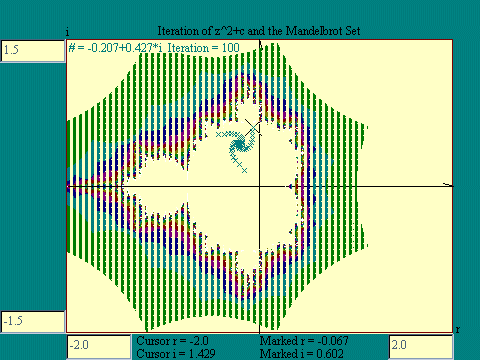
|
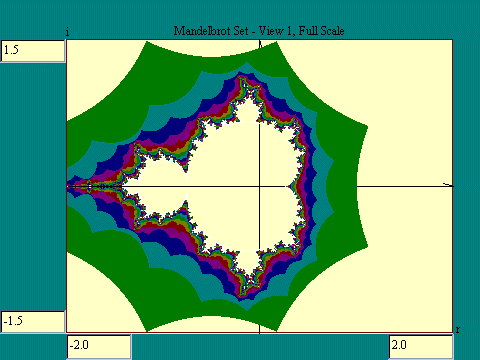
|
In the next display we will again paint the boundary of the
Mandelbrot set. This time allow the program to complete the
portrait so you may see the intricate detail. Those points in the
boundary closest to the set, based on escape time, we color
white. Farther out we use a rotating multi-color scheme in which
the colors repeat as we get farther and farther from the set.
Finally if the point is far enough from the set so that
divergence occurs quickly we leave the point background color. This coloring
provides contrast between regions. Run the
Mandelbrot Set - View 1, Full Scale display, or just look at
the image below.
You may have noticed that the central feature of the Mandelbrot
set is basically a series of disks. The disks have irregular
borders and decrease in size as we proceed along the negative
real axis. And the ratio of the diameter of one disk to the next
approaches a constant as we look deeper and deeper into the
series of disks.
And the constant which the ratio approaches is the Feigenbaum
number, approximately 4.669.
So what is going on here. The same number keeps popping up in
seemingly unrelated places. The logistic function is a quadratic,
the sine function is trigonometric, the Gaussian is exponential
and the Mandelbrot set is none of these. The common thread in the
universality of the Feigenbaum number is iteration. Is it the
iterative process itself that brings this order to chaos? When we
produce an object through iteration like an attractor or a
Mandelbrot set, the whole is made of parts repeated. The details
on a small scale resemble pieces in larger scale.
The notion of things looking the same on different scales has
profound implications. Turbulent flow in a fluid exhibits this
characteristic. There are eddies within eddies within eddies
mixed with smooth regions. Water at the point of boiling, clouds,
metals making the transition to magnetism, many badly behaved
physical systems exhibit scaling. To the mathematically
sophisticated, the geometric regularity shown by Feigenbaum's
number implies scaling phenomena. The universality of it means
that difficult problems might be understood by solving simple
ones.
|
|
If you are intrigued by the line of thought we have been
exploring in the last few paragraphs you will have to follow up
this course with additional study. We are about at the limit of
our exploration in this direction. It was in the years around 1970
that the foundations of this science was being put down.
There has been considerable building on those foundations in the
last decades and now there are structures upon which even
ordinary folks like us can stand and perhaps see farther than
before. I urge you to go as high as your curiosity can take
you.
In the next few displays we offer pictures of different parts
of the Mandelbrot set. The intention is to illustrate the wealth
of variety contained in the set which is defined so simply. This
may be the extreme example of complexity arising from simple
origins. We got our first look at this phenomena back in the
section on phase control maps when we iterated the logistic
function. In the Mandelbrot set there is literally infinite
variety. No one has yet seen all the detail available to you
through this program. In the research mode of this section you
will be able to explore for a lifetime. Run the Mandelbrot Set -
View 2 through - View 6. The only difference in these views is
the portion of the complex plane at which we are looking.
|
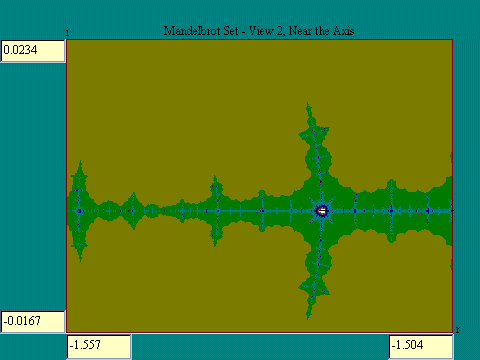
|
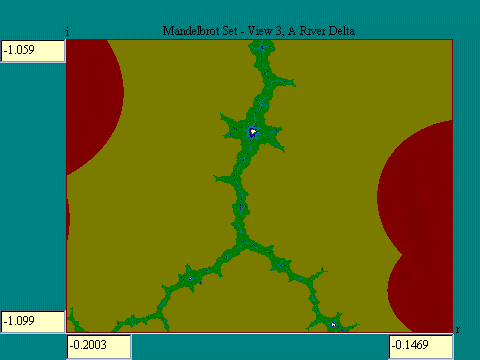
|
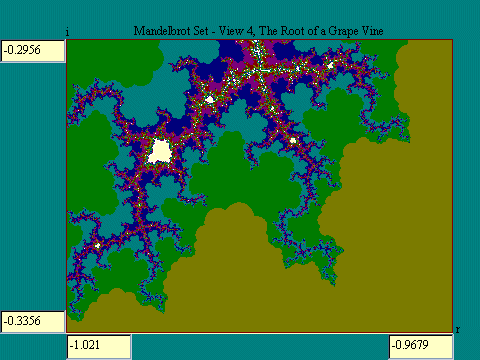
|
|
Next we will zoom in on a region of the Mandelbrot set
boundary. Multiple passes allow you to get an early look at the
picture with details added as time goes on. Points associated
with a particular number of iterations to divergence (escape
time) indicated by color, are laid out in intricate patterns. The
patterns are infinitely detailed fractals. The area to be
expanded to full screen is outlined by a box in a contrasting color. Run the
Mandelbrot Set - View 7 display to see the location of the first
zoom box. Then run the Mandelbrot Set - View 8 for the first
zoom.
|
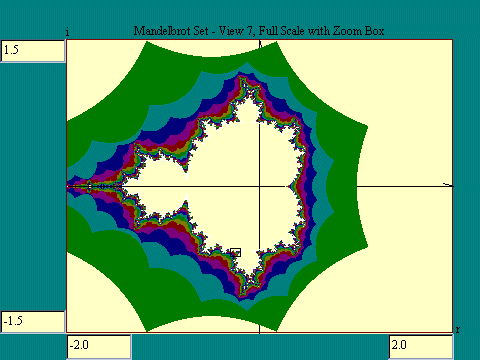
|
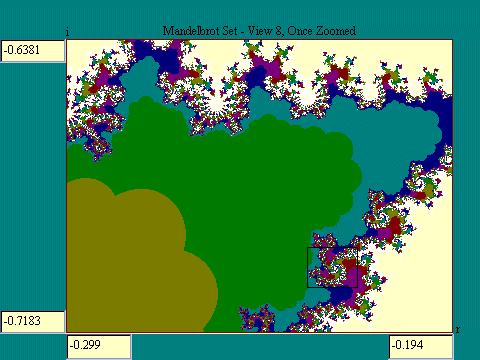
|
If we think of the set boundary as a coastline, we have zoomed in
here on a peninsula, not quite all the way to the point. If this
were a coastline it would have to be Maine. It is ragged in the
extreme. Next we will zoom in on the sort of spiral structure
enclosed in the box. Run the Mandelbrot Set - View 9.
|
|
We introduced fractals earlier in this course but let us
review the concept. The whole Mandelbrot set is contained in the
complex plane such that a circle of radius 2.5 centered at zero
would completely enclose it. The boundary though is of infinite
length. This is tough to visualize without a program like this
one to actually plot the points in the set. Lines of finite
extent but infinite length we know to be fractals. Fractals
involve an interesting concept in addition to fractional
dimension. That is "self-similarity". The boundary of
this set illustrates that.
Self-similarity means that as you look at a structure under
magnification you see tiny pieces of it that look like the whole
thing. With this program you begin with the outline of the entire
set. In a later display you may set up a window on the plot to
examine any portion of it in greater detail. By repeatedly
zooming in on the details you will see that the boundary is
indeed infinite and that there are regions which look like the
outline of the entire set. The Mandelbrot set also exhibits
"symmetry". Not the rigid symmetry of geometric figures
but an approximation of nature's own.
Symmetry in this context refers to sameness on both sides of
some axis. Generally mathematical functions that exhibit
symmetry are identically symmetrical. The whole Mandelbrot set in
fact has this kind of symmetry about the real axis. The set
boundary however on closer inspection has regions of "almost
symmetry" which are reminiscent of the symmetry of trees and
frogs. A most unexpected and unmathematical thing to find in a
structure defined in only a few lines of computer code. In fact
with a little imagination one may see rivers, valleys, islands
and mountains in the set. Now run The Mandelbrot Set - View 10
display.
|
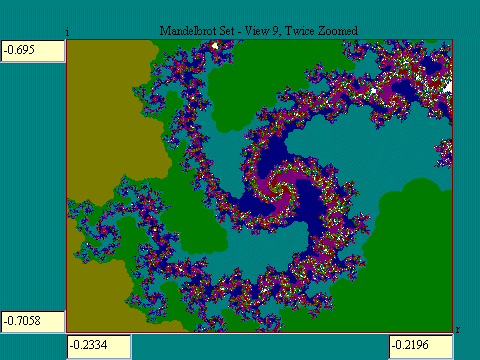
|
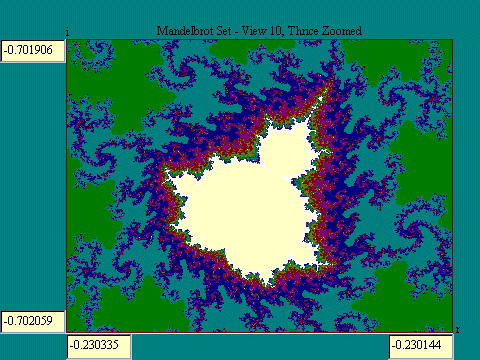
|
In the last display you saw a copy of the whole Mandelbrot set
on a scale about 1:20000. Just to clarify a point, the scale
refers to linear dimensions. The area of this display in the
complex plane is about 1/400,000,000 of the full-scale display.
If you are willing to wait for the picture to develop, you have a
very powerful microscope here. Soon you will be able to control
the magnification by repeated zooming to smaller and smaller
scales. There is a limit inherent in the way personal computers
deal with floating point decimal numbers, in how far we can take
this magnification.
The number of significant digits in numbers handled by PCs is
limited to about 15. The computer has trouble telling the
difference between 100000.0000000001 and 100000.0. When the
finest details of the plot we are making approaches this scale,
there is uncertainty about exactly which pixels represent the
actual value. Since several pixels may all represent the same
value, they all are lit. This gives the picture a blocky
appearance. Ultimately every pixel on the screen might be lit for
a single point, reducing the resolution of the picture to
zero.

Are there any questions?
|

 Next Next
 Previous
Previous
 Other
Other
|




